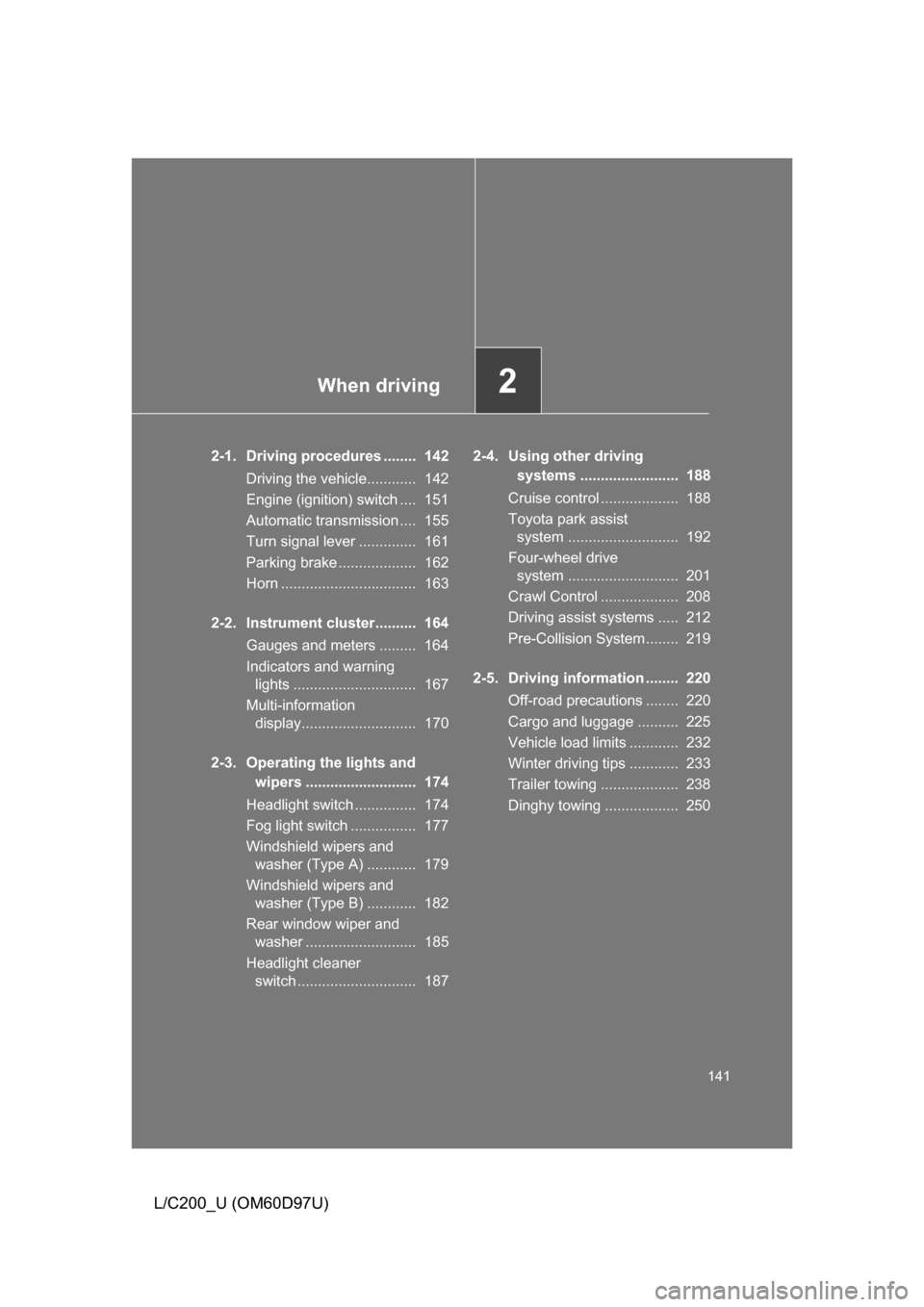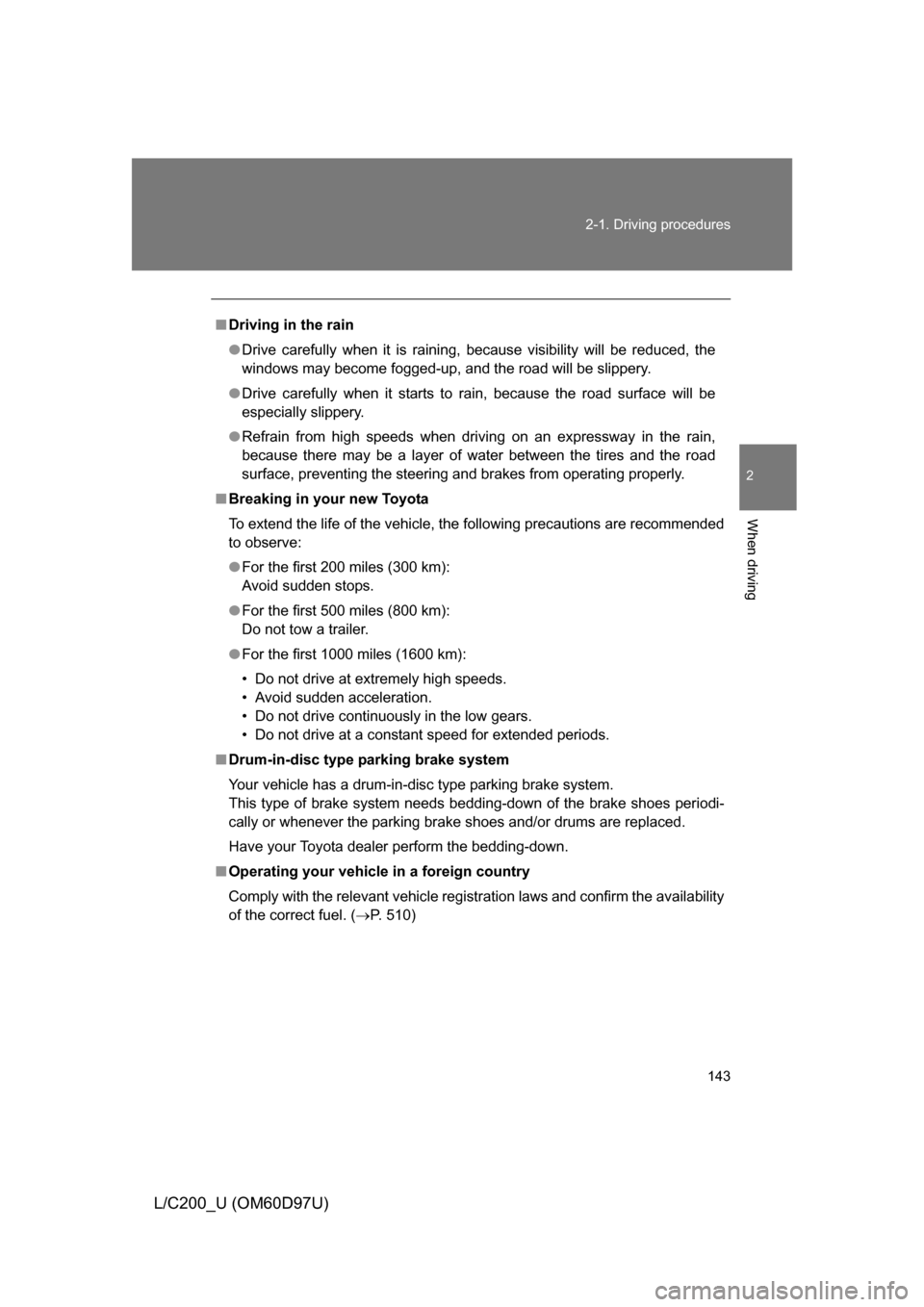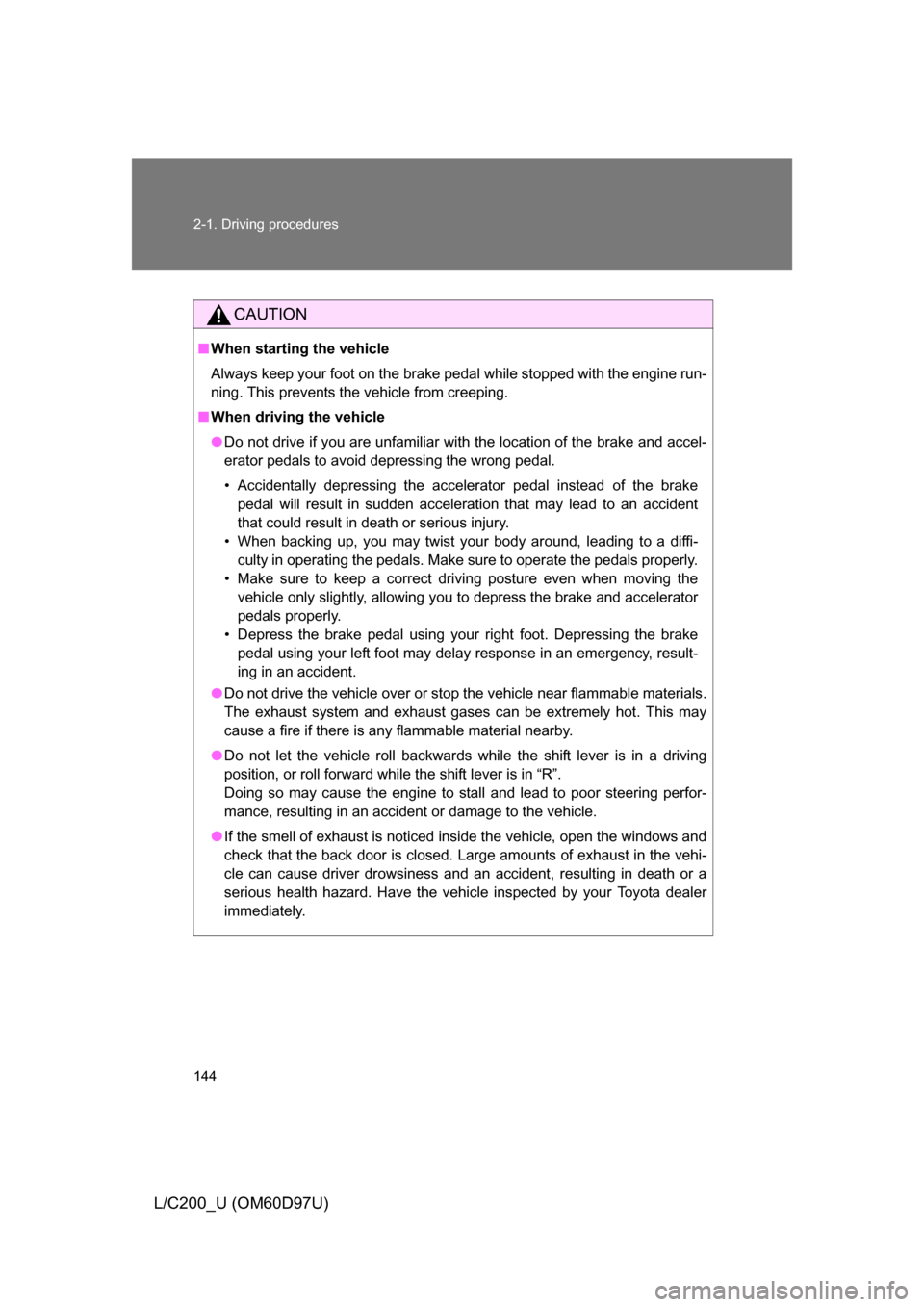Page 141 of 556

When driving2
141
L/C200_U (OM60D97U)
2-1. Driving procedures ........ 142Driving the vehicle............ 142
Engine (ignition) switch .... 151
Automatic transmission .... 155
Turn signal lever .............. 161
Parking brake ................... 162
Horn ................................. 163
2-2. Instrument cluster.......... 164 Gauges and meters ......... 164
Indicators and warning lights .............................. 167
Multi-information display............................ 170
2-3. Operating the lights and wipers ........................... 174
Headlight switch ............... 174
Fog light switch ................ 177
Windshield wipers and washer (Type A) ............ 179
Windshield wipers and washer (Type B) ............ 182
Rear window wiper and washer ........................... 185
Headlight cleaner switch ............................. 187 2-4. Using other driving
systems ........................ 188
Cruise control ................... 188
Toyota park assist system ........................... 192
Four-wheel drive system ........................... 201
Crawl Control ................... 208
Driving assist systems ..... 212
Pre-Collision System........ 219
2-5. Driving information ........ 220 Off-road precautions ........ 220
Cargo and luggage .......... 225
Vehicle load limits ............ 232
Winter driving tips ............ 233
Trailer towing ................... 238
Dinghy towing .................. 250
Page 143 of 556

143
2-1. Driving procedures
2
When driving
L/C200_U (OM60D97U)
■
Driving in the rain
● Drive carefully when it is raining, because visibility will be reduced, the
windows may become fogged-up, and the road will be slippery.
● Drive carefully when it starts to rain, because the road surface will be
especially slippery.
● Refrain from high speeds when driving on an expressway in the rain,
because there may be a layer of water between the tires and the road
surface, preventing the steering and brakes from operating properly.
■ Breaking in your new Toyota
To extend the life of the vehicle, the following precautions are recommended
to observe:
● For the first 200 miles (300 km):
Avoid sudden stops.
● For the first 500 miles (800 km):
Do not tow a trailer.
● For the first 1000 miles (1600 km):
• Do not drive at extremely high speeds.
• Avoid sudden acceleration.
• Do not drive continuously in the low gears.
• Do not drive at a constant speed for extended periods.
■ Drum-in-disc type parking brake system
Your vehicle has a drum-in-disc type parking brake system.
This type of brake system needs bedding-down of the brake shoes periodi-
cally or whenever the parking brake shoes and/or drums are replaced.
Have your Toyota dealer perform the bedding-down.
■ Operating your vehicle in a foreign country
Comply with the relevant vehicle registration laws and confirm the availability
of the correct fuel. ( P. 510)
Page 144 of 556

144 2-1. Driving procedures
L/C200_U (OM60D97U)
CAUTION
■When starting the vehicle
Always keep your foot on the brake pedal while stopped with the engine run-
ning. This prevents the vehicle from creeping.
■ When driving the vehicle
● Do not drive if you are unfamiliar with the location of the brake and accel-
erator pedals to avoid depressing the wrong pedal.
• Accidentally depressing the accelerator pedal instead of the brake
pedal will result in sudden acceleration that may lead to an accident
that could result in death or serious injury.
• When backing up, you may twist your body around, leading to a diffi- culty in operating the pedals. Make sure to operate the pedals properly.
• Make sure to keep a correct driving posture even when moving the vehicle only slightly, allowing you to depress the brake and accelerator
pedals properly.
• Depress the brake pedal using your right foot. Depressing the brake pedal using your left foot may delay response in an emergency, result-
ing in an accident.
● Do not drive the vehicle over or st op the vehicle near flammable materials.
The exhaust system and exhaust gases can be extremely hot. This may
cause a fire if there is any flammable material nearby.
● Do not let the vehicle roll backwards while the shift lever is in a driving
position, or roll forward while the shift lever is in “R”.
Doing so may cause the engine to stall and lead to poor steering perfor-
mance, resulting in an accident or damage to the vehicle.
● If the smell of exhaust is noticed inside the vehicle, open the windows and
check that the back door is closed. Large amounts of exhaust in the vehi-
cle can cause driver drowsiness and an accident, resulting in death or a
serious health hazard. Have the vehicle inspected by your Toyota dealer
immediately.
Page 180 of 556
180 2-3. Operating the lights and wipers
L/C200_U (OM60D97U)
■The windshield wiper and washer can be operated when
The “ENGINE START STOP” switch is in IGNITION ON mode.
■ If no windshield washer fluid sprays
Check that the washer nozzles are not blocked if there is washer fluid in the
windshield washer fluid reservoir.
■ In extremely hot or cold weather
The system will turn off if the windshield gets extremely hot (at more than
176 F [80 C]) or cold (at less than -14 F [-10 C]).
■ Windshield wiper features
The rear window and outside rear view mirror defoggers automatically turn
on when you operate the wipers.
■ Customization that can be co nfigured at Toyota dealer
Settings (e.g. drip prevention function) can be changed.
(Customizable features P. 533)
Washer/wiper dual opera-
tion
Wipers operate automatically.
ITO23C056
Page 183 of 556
183
2-3. Operating the lights and wipers
2
When driving
L/C200_U (OM60D97U)
■
The windshield wiper and washer can be operated when
The “ENGINE START STOP” switch is in IGNITION ON mode.
■ If no windshield washer fluid sprays
Check that the washer nozzles are not blocked if there is washer fluid in the
windshield washer fluid reservoir.
■ In extremely hot or cold weather
The system will turn off if the windshield gets extremely hot (at more than
176 F [80 C]) or cold (at less than -14 F [-10 C]).
■ Windshield wiper features
The rear window and outside rear view mirror defoggers automatically turn
on when you operate the wipers.
■ Customization that can be co nfigured at Toyota dealer
Settings (e.g. drip prevention function) can be changed.
(Customizable features P. 533)
Washer/wiper dual opera-
tion
Wipers operate automatically.
ITO23C081
Page 185 of 556
185
2-3. Operating the lights and wipers
2
When driving
L/C200_U (OM60D97U)
Rear window wiper and washer
Ty p e AIntermittent window wiper
operation
Normal window wiper oper-
ation
Washer operation
Washer operation
ITO23C057
Page 186 of 556
186 2-3. Operating the lights and wipers
L/C200_U (OM60D97U)
■The rear window wiper and w asher can be operated when
The “ENGINE START STOP” switch is in IGNITION ON mode.
NOTICE
■ When the rear window is dry
Do not use the wipers, as they may damage the rear window.
Ty p e B
Intermittent window wiper
operation
Normal window wiper oper-
ation
Washer operation
Washer operation
ITO23C088
Page 234 of 556
234 2-5. Driving information
L/C200_U (OM60D97U)
■Before driving the vehicle
Perform the following according to the driving conditions.
●Do not try to forcibly open a window or move a wiper that is
frozen. Pour warm water over the frozen area to melt the ice.
Wipe away the water immediately to prevent it from freezing.
● To ensure proper operation of th e climate control system fan,
remove any snow that has accumulated on the air inlet vents
in front of the windshield.
● Remove any ice that has accumu lated on the vehicle chassis.
● Periodically check for and remove any excess ice or snow
that may have accumulated in the wheel well or on the
brakes.
■ When driving the vehicle
Accelerate the vehicle slowly and drive at a reduced speed suit-
able to road conditions.
■ When parking the vehicle
Park the vehicle and move the shift lever to “P” without setting
the parking brake. The parking brake may freeze up, preventing
it from being released.